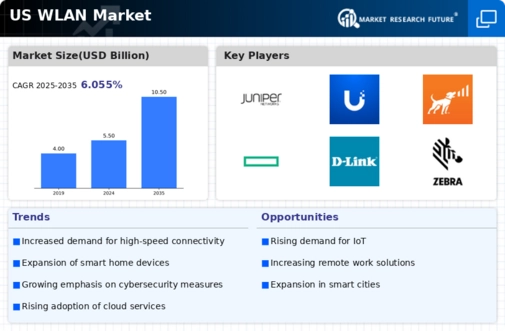Expansion of Smart Devices
The proliferation of smart devices is significantly influencing the wlan market. With the rise of the Internet of Things (IoT), an increasing number of devices are connecting to wireless networks. According to recent estimates, there are over 30 billion connected devices globally, with a substantial portion located in the US. This trend necessitates robust wlan solutions to manage the growing number of connections efficiently. As consumers and businesses adopt smart home technologies, wearables, and connected appliances, the demand for reliable and high-capacity wlan networks is likely to escalate. Consequently, this expansion is expected to propel the wlan market forward, as companies invest in upgrading their wireless infrastructure.
Growing Demand for High-Speed Internet
The increasing demand for high-speed internet access is a primary driver in the wlan market. As more households and businesses seek reliable connectivity, the need for advanced wireless solutions intensifies. In the US, the Federal Communications Commission (FCC) reported that approximately 90% of Americans now have access to broadband, which has led to a surge in the deployment of wlan technologies. This trend is expected to continue, with the wlan market projected to grow at a CAGR of around 15% over the next five years. Enhanced speed and capacity are essential for supporting applications such as streaming, online gaming, and remote work, thereby driving investments in wlan infrastructure.
Emergence of Advanced Wireless Standards
The introduction of advanced wireless standards is a significant driver in the wlan market. Technologies such as Wi-Fi 6 and the upcoming Wi-Fi 7 are designed to improve network efficiency, speed, and capacity. These advancements are particularly relevant in the US, where the demand for high-performance wireless networks continues to rise. The wlan market is likely to benefit from the adoption of these standards, as they enable better performance in environments with multiple connected devices. As consumers and businesses seek to optimize their wireless experiences, the transition to these advanced standards is expected to accelerate, further propelling the growth of the wlan market.
Increased Focus on Remote Work Solutions
The shift towards remote work has created a notable impact on the wlan market. Organizations are increasingly investing in wireless solutions to facilitate seamless communication and collaboration among remote teams. A survey indicated that over 70% of companies in the US plan to maintain flexible work arrangements, which underscores the need for reliable wlan connectivity. This trend has prompted businesses to enhance their wireless networks to support video conferencing, cloud applications, and other collaborative tools. As a result, the wlan market is likely to experience growth as companies prioritize investments in advanced wireless technologies to ensure productivity and connectivity for their remote workforce.
Regulatory Support for Broadband Expansion
Regulatory initiatives aimed at expanding broadband access are playing a crucial role in shaping the wlan market. The US government has implemented various programs to promote the deployment of high-speed internet in underserved areas. For instance, the FCC's Rural Digital Opportunity Fund allocates $20.4 billion to support broadband expansion in rural communities. Such initiatives are expected to drive the demand for wlan technologies as service providers seek to enhance their infrastructure. This regulatory support not only fosters competition among providers but also encourages innovation in wireless solutions, thereby contributing to the overall growth of the wlan market.

























Leave a Comment